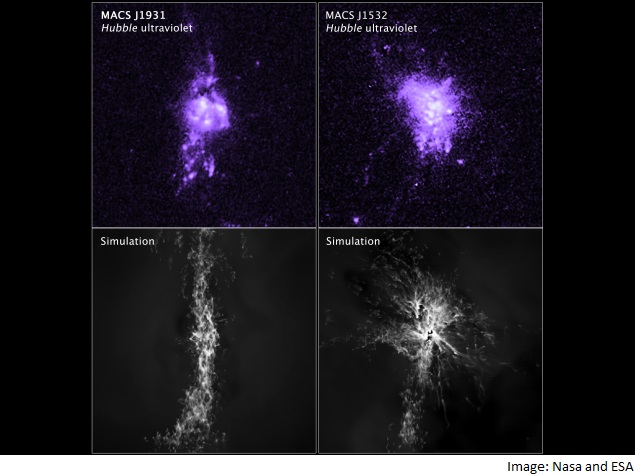- Home
- Science
- Science News
- Nasa's Hubble Uncovers Galaxy Star Birth Regulated by Black Hole Fountain
Nasa's Hubble Uncovers Galaxy Star Birth Regulated by Black-Hole Fountain

Nasa's Hubble Space Telescope allowed the astronomers to see brilliant knots of hot, blue stars forming along the jets of active black holes found in the centres of giant elliptical galaxies.
Combining Hubble data with observations from a suite of ground-based and space telescopes, two independent teams found that that the black hole, jets, and newborn stars are all parts of a self-regulating cycle.
High-energy jets shooting from the black hole heat a halo of surrounding gas, controlling the rate at which the gas cools and falls into the galaxy.
"Think of the gas surrounding a galaxy as an atmosphere. That atmosphere can contain material in different states, just like our own atmosphere has gas, clouds, and rain," said Megan Donahue from the Michigan State University.
What we are seeing is a process like a thunderstorm.
"As the jets propel gas outward from the centre of the galaxy, some of that gas cools and precipitates into cold clumps that fall back toward the galaxy's centre like raindrops," Donahue added.
The "raindrops" eventually cool enough to become star-forming clouds of cold molecular gas.
"We know that these showers are linked to the jets because they're found in filaments and tendrils that wrap around the jets or hug the edges of giant bubbles that the jets have inflated," said Grant Tremblay from Yale University.
This discovery explains the mystery of why many elliptical galaxies in the present-day universe are not ablaze with a higher rate of star birth.
An earlier independent study, led by Rupal Mittal of the Rochester Institute of Technology and the Max Planck Institute for Gravitational Physics, also analysed the star-birth rates in the same galaxies as Tremblay's sample.
The two papers was published in the Astrophysical Journal and the Monthly Notices of the Royal Astronomical Society.
For the latest tech news and reviews, follow Gadgets 360 on X, Facebook, WhatsApp, Threads and Google News. For the latest videos on gadgets and tech, subscribe to our YouTube channel. If you want to know everything about top influencers, follow our in-house Who'sThat360 on Instagram and YouTube.
Related Stories
- Galaxy S24 Series
- MWC 2024
- Apple Vision Pro
- Oneplus 12
- iPhone 14
- Apple iPhone 15
- OnePlus Nord CE 3 Lite 5G
- iPhone 13
- Xiaomi 14 Pro
- Oppo Find N3
- Tecno Spark Go (2023)
- Realme V30
- Best Phones Under 25000
- Samsung Galaxy S24 Series
- Cryptocurrency
- iQoo 12
- Samsung Galaxy S24 Ultra
- Giottus
- Samsung Galaxy Z Flip 5
- Apple 'Scary Fast'
- Housefull 5
- GoPro Hero 12 Black Review
- Invincible Season 2
- JioGlass
- HD Ready TV
- Laptop Under 50000
- Smartwatch Under 10000
- Latest Mobile Phones
- Compare Phones
- Motorola Edge 50 Fusion
- Oppo A1i
- Oppo A1s
- Motorola Edge 50 Ultra
- Leica Leitz Phone 3
- Moto G64 5G
- Moto G04s
- iQOO Z9 Turbo
- Asus ZenBook Duo 2024 (UX8406)
- Dell Inspiron 14 Plus
- Realme Pad 2 Wi-Fi
- Redmi Pad Pro
- Cult Shock X
- Fire-Boltt Oracle
- LG 65-inch 4K Ultra HD Smart LED TV 65UR7500PSC
- Xiaomi 32 Inch LED HD Ready Smart TV (L32M6-RA-L32M7-RA)
- Sony PlayStation 5 Slim Digital Edition
- Sony PlayStation 5 Slim
- Onida 1.5 Ton 3 Star Inverter Split AC (IR183TSN)
- Haier 1.5 Ton 3 Star Window AC (HWU18TF-EW3BE-FS)
















